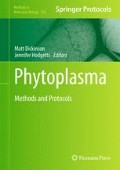Abstract
The iPhyClassifier is an internet-based research tool for quick identification and classification of diverse phytoplasmas. The iPhyClassifier simulates laboratory restriction enzyme digestions and subsequent gel electrophoresis and generates virtual restriction fragment length polymorphism (RFLP) patterns. Based on RFLP pattern similarity coefficient scores, the iPhyClassifier gives instant suggestions on group and subgroup classification status of the phytoplasma strains under study. The iPhyClassifier also aligns the query sequences with that of reference strains of all previously described ‘Candidatus Phytoplasma’ species, calculates sequence similarity scores, and assigns the phytoplasmas under study into respective ‘Ca. Phytoplasma’ species as related strains according to the guidelines set forth by the Phytoplasma Taxonomy Group of the International Research Program on Comparative Mycoplasmology. Additional functions of the iPhyClassifier include delineation of potentially new phytoplasma groups and subgroups as well as new ‘Ca. Phytoplasma’ species. This chapter describes the program components, the operational procedure, and the underlying principles of the iPhyClassifier operation. The chapter also provides hints on how to interpret the results.
Access this chapter
Tax calculation will be finalised at checkout
Purchases are for personal use only
References
Kuske CR, Kirkpatrick BC (1992) Phylogenetic relationships between the western aster yellows mycoplasmalike organism and other prokaryotes established by 16S rRNA gene sequence. Int J Syst Bacteriol 42:226–233
Namba S et al (1993) Phylogenetic diversity of phytopathogenic mycoplasmalike organisms. Int J Syst Bacteriol 43:461–467
Gundersen DE et al (1994) Phylogeny of mycoplasmalike organisms (phytoplasmas): a basis for their classification. J Bacteriol 176:5244–5254
Schneider B et al (1995) Phylogenetic classification of plant pathogenic mycoplasma-like organisms or phytoplasmas. In: Razin R, Tully JG (eds) Molecular and diagnostic procedures in mycoplasmology. Academic, San Diego, pp 369–380
Seemüller E et al (1998) Current status of molecular classification of the phytoplasmas. J Plant Pathol 80:3–26
Lee I-M et al (1993) Universal amplification and analysis of pathogen 16S rDNA for classification and identification of mycoplasmalike organisms. Phytopathology 83:834–842
Lee I-M et al (1998) Revised classification scheme of phytoplasmas based on RFLP analyses of 16S rRNA and ribosomal protein gene sequences. Int J Syst Bacteriol 48:1153–1169
Lee I-M, Davis RE, Gundersen-Rindal DE (2000) Phytoplasma: phytopathogenic mollicutes. Annu Rev Microbiol 54:221–255
Schneider B et al (1993) Classification of plant-pathogenic mycoplasma-like organisms using restriction-site analysis of PCR-amplified 16S rDNA. Microbiology 139:519–527
Lee I-M et al (2006) ‘Candidatus Phytoplasma americanum’, a phytoplasma associated with a potato purple top wilt disease complex. Int J Syst Evol Microbiol 56:1593–1597
Wei W et al (2007) Computer-simulated RFLP analysis of 16S rRNA genes: identification of ten new phytoplasma groups. Int J Syst Evol Microbiol 57:1855–1867
Wei W et al (2008) Automated RFLP pattern comparison and similarity coefficient calculation for rapid delineation of new and distinct phytoplasma 16Sr subgroup lineages. Int J Syst Evol Microbiol 58:2368–2377
Zhao Y et al (2009) ‘Candidatus Phytoplasma tamaricis’, a novel taxon discovered in witches’-broom-diseased salt cedar (Tamarix chinensis Lour.). Int J Syst Evol Microbiol 59:2496–2504
Zhao Y et al (2009) Construction of an interactive online phytoplasma classification tool, iPhyClassifier, and its application in analysis of the peach X-disease phytoplasma group (16SrIII). Int J Syst Evol Microbiol 59:2582–2593
Jomantiene R et al (2010) Onion is host for two phytoplasma lineages, subgroups 16SrI-A and 16SrI-(B/L)L, in Lithuania: a HinfI site revealed a SNP marking divergent branches of evolution. J Plant Pathol 92:461–470
Jomantiene R et al (2011) Phytoplasmas infecting sour cherry and lilac represent two distinct lineages having close evolutionary affinities with clover phyllody phytoplasma. Eur J Plant Pathol 130:97–107
Lee I-M et al (2011) ‘Candidatus Phytoplasma costaricanum’, a new phytoplasma associated with a newly emerging disease in soybean in Costa Rica. Int J Syst Evol Microbiol. doi:10.1099/ijs.0.029041-0
The IRPCM Phytoplasma/Spiroplasma Working Team—Phytoplasma taxonomy group (2004) ‘Candidatus Phytoplasma’, a taxon for the wall-less, non-helical prokaryotes that colonize plant phloem and insects. Int J Syst Evol Microbiol 54:1243–1255
Pearson WR, Lipman DJ (1988) Improved tools for biological sequence comparison. PNAS USA 85:2444–2448
Altschul SF et al (1990) Basic local alignment search tool. J Mol Biol 215:403–410
Thompson JD, Higgins DG, Gibson TJ (1994) CLUSTALW: improving the sensitivity of progressive multiple sequence alignment through sequence weighting, position-specific gap penalties and weight matrix choice. Nucl Acids Res 22:4673–4680
Schneider B, Seemüller E (1994) Presence of two sets of ribosomal genes in phytopathogenic mollicutes. Appl Environ Microbiol 60:3409–3412
Liefting LW et al (1996) Sequence heterogeneity in the two 16S rRNA genes of Phormium yellow leaf phytoplasma. Appl Environ Microbiol 62:3133–3139
Davis RE, Sinclair WA (1998) Phytoplasma identity and disease etiology. Phytopathology 88:1372–1376
Davis RE, Dally EL (2001) Nonfunctional tRNA gene in an unusual example of rRNA interoperon sequence heterogeneity in phytoplasma. Phytopathology 91:S21
Davis RE et al (2003) Differential amplification of sequence heterogeneous ribosomal RNA genes and classification of the ‘Fragaria multicipita’ phytoplasma. Microbiol Res 158:229–236
Jomantiene R et al (2002) New group 16SrIII phytoplasma lineages in Lithuania exhibit interoperon sequence heterogeneity. Eur J Plant Pathol 108:507–517
Nei M, Li W-H (1979) Mathematical model for studying genetic variation in terms of restriction endonucleases. PNAS USA 76:5269–5273
Gundersen DE, Lee I-M (1996) Ultrasensitive detection of phytoplasmas by nested-PCR assays using two universal primer pairs. Phytopathol Mediterr 35:144–151
Murray RGE, Schleifer KH (1994) Taxonomic notes: a proposal for recording the properties of putative taxa of prokaryotes. Int J Syst Bacteriol 44:174–176
Stackebrandt E, Goebel BM (1994) Taxonomic note: a place for DNA-DNA reassociation and 16S rRNA sequence analysis in the present species definition in bacteriology. Int J Syst Bacteriol 44:846–849
Author information
Authors and Affiliations
Corresponding author
Editor information
Editors and Affiliations
Rights and permissions
Copyright information
© 2013 Springer Science+Business Media, LLC
About this protocol
Cite this protocol
Zhao, Y., Wei, W., Lee, IM., Shao, J., Suo, X., Davis, R.E. (2013). The iPhyClassifier, an Interactive Online Tool for Phytoplasma Classification and Taxonomic Assignment. In: Dickinson, M., Hodgetts, J. (eds) Phytoplasma. Methods in Molecular Biology, vol 938. Humana Press, Totowa, NJ. https://doi.org/10.1007/978-1-62703-089-2_28
Download citation
DOI: https://doi.org/10.1007/978-1-62703-089-2_28
Published:
Publisher Name: Humana Press, Totowa, NJ
Print ISBN: 978-1-62703-088-5
Online ISBN: 978-1-62703-089-2
eBook Packages: Springer Protocols

